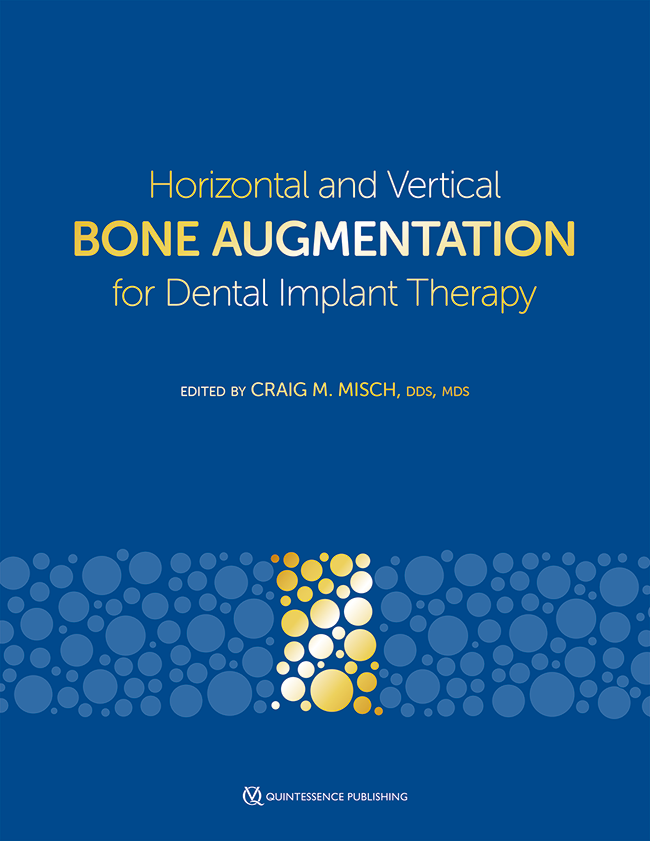International Journal of Oral Implantology, 3/2023
PubMed ID (PMID): 37767613Pages 171-172, Language: EnglishMisch, Craig M.EditorialInternational Journal of Oral Implantology, 4/2022
PubMed ID (PMID): 36377622Pages 303-304, Language: EnglishMisch, Craig M.EditorialInternational Journal of Oral Implantology, 2/2022
PubMed ID (PMID): 35546721Pages 103-104, Language: EnglishMisch, Craig M.EditorialInternational Journal of Oral Implantology, 1/2022
PubMed ID (PMID): 35266664Pages 3-4, Language: EnglishMisch, Craig M.EditorialInternational Journal of Oral Implantology, 4/2021
PubMed ID (PMID): 34726845Pages 343-344, Language: EnglishMisch, Craig M. / Wang, Hom-LayInternational Journal of Oral Implantology, 3/2021
PubMed ID (PMID): 34415126Pages 235-237, Language: EnglishMisch, Craig M.International Journal of Oral Implantology, 2/2021
PubMed ID (PMID): 34006076Pages 119-120, Language: EnglishMisch, Craig M.The International Journal of Oral & Maxillofacial Implants, 1/2021
Pages 122-125, Language: EnglishBasma, Hussein S. / Misch, Craig M.Purpose: The aim of this retrospective study was to determine if penicillin allergy and/or clindamycin therapy may contribute to a higher incidence of postsurgical infections after bone augmentation.
Materials and Methods: This retrospective study analyzed patients between 2014 and 2019 who received bone augmentation procedures (socket grafting [SG]; ridge augmentation [RA]) prior to placement of dental implants. All the grafting procedures were performed under preoperative and postoperative oral antibiotic coverage with either amoxicillin or clindamycin for patients who reported penicillin allergy. Infections associated with the bone augmentation procedures were recorded.
Results: In this study, 1,814 patients received 2,961 bone augmentation procedures (2,530 SG, 431 RA). In the 2,530 SG procedures, 270 (10.7%) were associated with a penicillin allergy. Infections occurred in 91 of the 2,530 SG sites (3.6%). However, the infection rate was 10.7% (29 SG sites) for clindamycin and only 2.7% (62 SG sites) for amoxicillin (P < .02). In the 431 RA procedures, 71 (16.5%) were associated with a penicillin allergy. Overall infections occurred in 31 of the 431 sites (7.2%). However, the infection rate was 22.5% (16 RA sites) for clindamycin and only 4.2% for amoxicillin (15 RA sites; P < .01). Penicillin-allergic patients taking clindamycin demonstrated a higher risk of infection with a risk ratio of 6.9 (95% CI) and 4.5 (95% CI) compared with nonallergic patients taking amoxicillin for RA and SG, respectively.
Conclusion: Penicillin allergy and the use of clindamycin following SG and RA procedures was associated with a higher rate of infection and may be a risk factor for bone augmentation complications.
International Journal of Oral Implantology, 1/2021
PubMed ID (PMID): 34006067Pages 3-4, Language: EnglishMisch, Craig M.International Journal of Periodontics & Restorative Dentistry, 1/2021
Pages 11-21, Language: EnglishMisch, Craig M. / Basma, Hussein / Misch-Haring, Maggie A. / Wang, Hom-LayVertical bone augmentation (VBA) procedures for dental implant placement are biologically and technically challenging. Systematic reviews and meta-analyses of studies on VBA have failed to identify clinical procedures that provide superior results for treatment of the vertical ridge deficiencies. A decision tree was developed to guide clinicians on selecting treatment options based on reported vertical bone gains (< 5 mm, 5 to 8 mm, > 8 mm). The choice of a particular augmentation technique will also depend on other factors, including the size and morphology of the defect, location, and clinician or patient preferences. Surgeons should consider the advantages and disadvantages of each option for the clinical situation and select an approach with low complications, low cost, and the highest likelihood of success.





